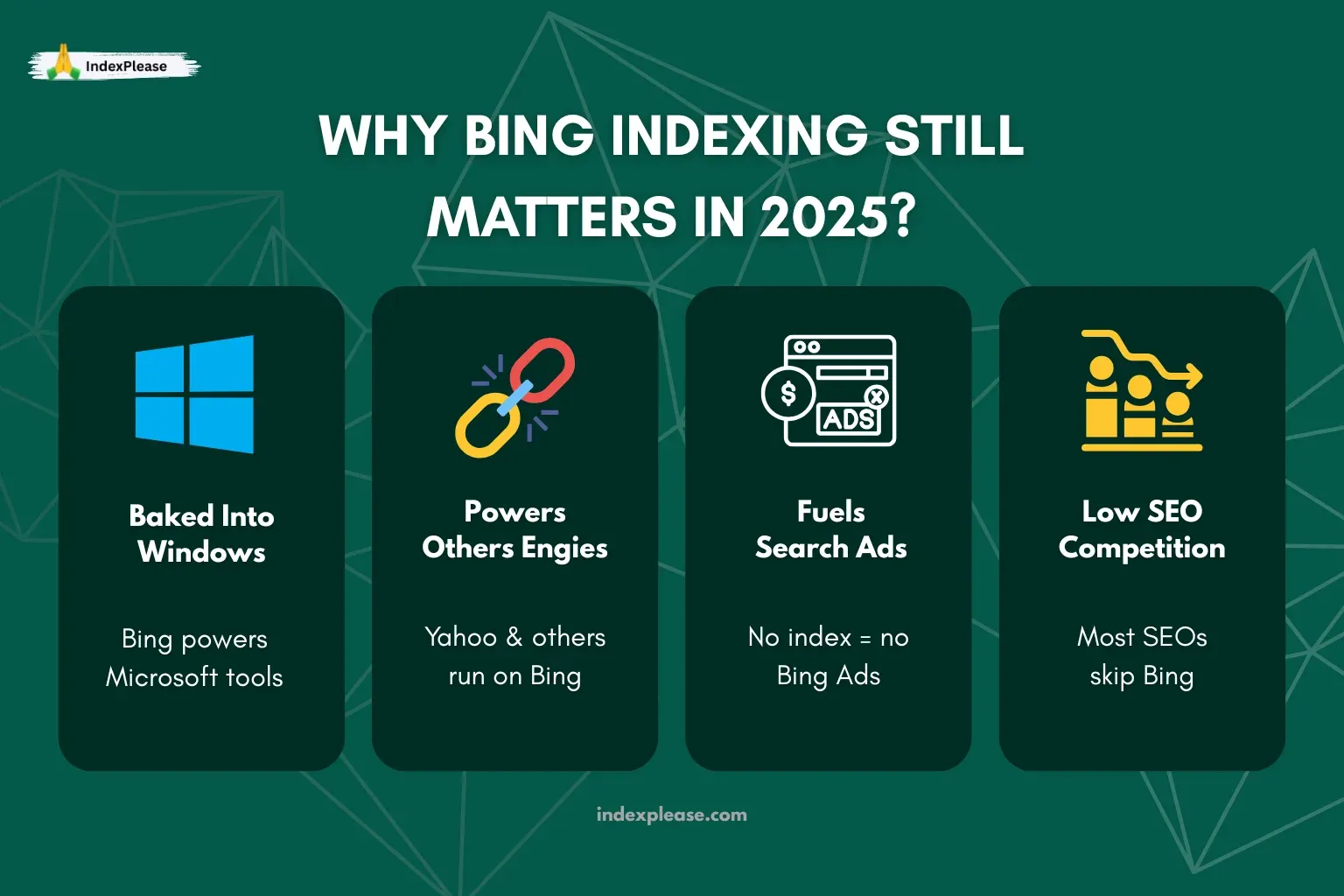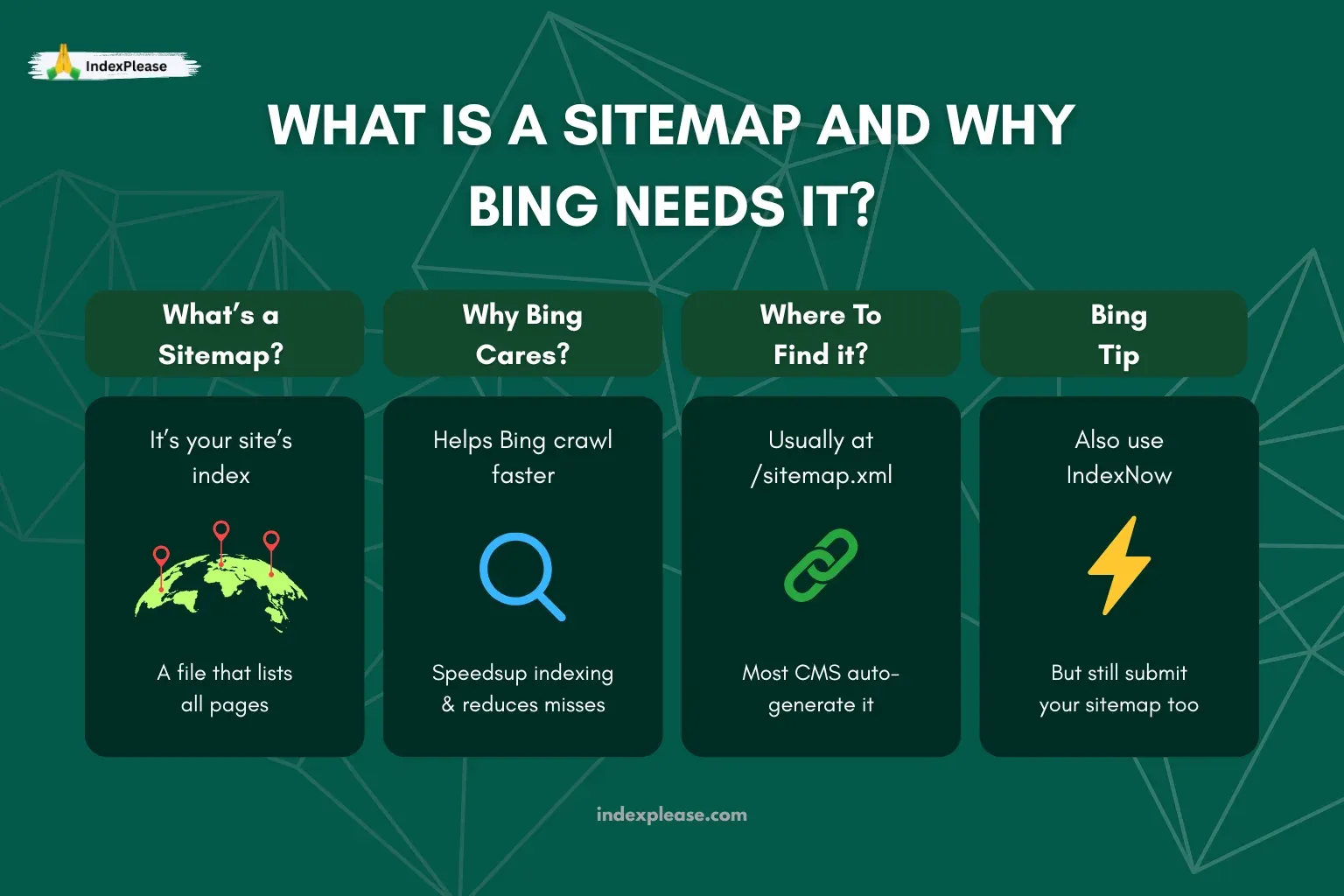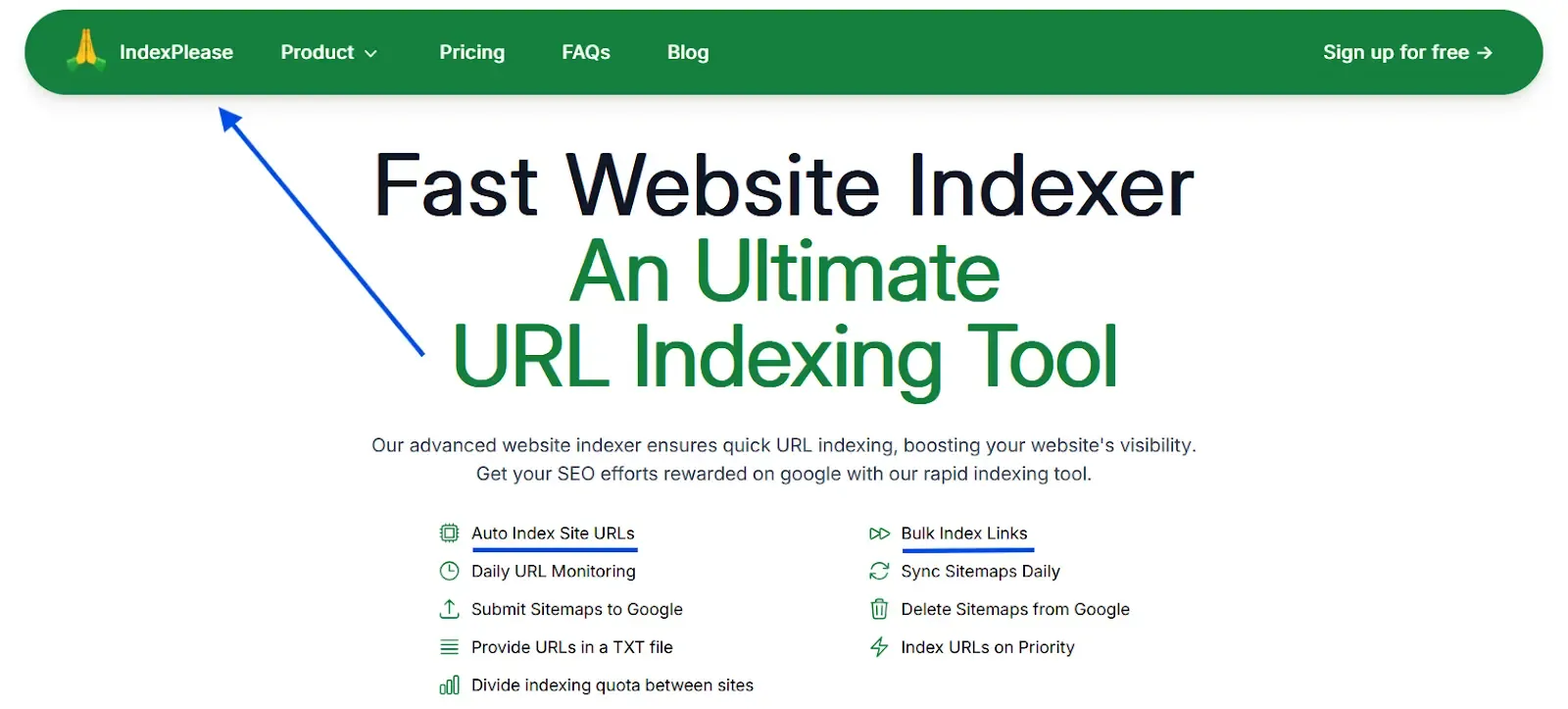
How to submit your sitemap to Bing
Let’s be honest, most SEOs obsess over Google. But Bing quietly powers billions of searches each month across platforms you might not even think about: Microsoft Edge, ChatGPT (with browsing), Windows Search, DuckDuckGo and even Yahoo.
Ignoring Bing means leaving visibility, clicks and revenue on the table, especially when indexing isn’t guaranteed just because you hit “publish.”
Unlike Google, Bing can be surprisingly open to smaller sites, faster to index well-structured pages and less punishing with updates. But only if you play by its rules.
That’s where this guide comes in. We’ll break down exactly how Bing indexing works today, why it often fails silently and what steps you can take, from manual submissions to auto-indexing via tools like IndexPlease, to make sure your content actually gets seen.
Because ranking doesn’t matter if Bing never indexes you in the first place.
Why Bing Indexing Still Matters in 2025

Bing isn’t just “the other search engine.” It’s baked into everything Microsoft and that reach is deeper than you think:
- Microsoft Edge remains the default browser on hundreds of millions of PCs.
- Windows Copilot and ChatGPT with Bing use Bing’s search API to serve real-time web results.
- DuckDuckGo, Yahoo and other engines still rely on Bing’s infrastructure to deliver results.
- Bing Ads fuel shopping visibility across these channels, but none of it works if your site isn’t indexed.
And here’s the twist: Most SEOs still ignore Bing. That means less competition for your keywords, easier rankings and faster discovery, if your pages actually get picked up.
Bing is also evolving its own AI summarization and rich result capabilities. So structured data, schema and clean HTML aren’t just Google priorities anymore, they’re required to surface anywhere useful.
The result? Indexing on Bing is not optional, it’s a quick win for smart SEOs and lean teams.
What Is a Sitemap and Why Bing Needs It

If search engines are like librarians, your sitemap is the index card that tells them what’s on the shelf. It’s a structured file, usually in XML format, that lists all the important pages on your website. Think of it as a roadmap for your site, built specifically for search bots.
While Bing can technically crawl your site without one, submitting a sitemap to Bing gives it a clear signal:
“Here are my most important pages, go crawl and index them.”
Without a sitemap, Bing might:
- Miss newly published pages
- Take longer to index updates
- Skip over pages with weak internal links
If you’re serious about Bing search optimization, giving the crawler a sitemap is a basic, but powerful, step.
What Does a Sitemap Look Like?
It’s usually a file located at: https://yourdomain.com/sitemap.xml
Modern SEO platforms like WordPress (with Rank Math or Yoast), Ghost and Shopify all auto-generate this file for you.
If you’re using WordPress, your sitemap is likely at: https://yourdomain.com/sitemap_index.xml
Does Bing Use the Sitemap Differently Than Google?
Not really. But here’s the key difference: Bing also supports IndexNow, a protocol that works even faster than sitemaps, but it still recommends submitting your sitemap via Bing Webmaster Tools for full coverage.
In short: If you want your website indexed on Bing quickly and completely, submitting a sitemap is Step 1.
Step-by-Step: Submitting Your Sitemap to Bing Webmaster Tools

Once you have your sitemap URL (like yourdomain.com/sitemap.xml), it’s time to tell Bing about it. Submitting your sitemap to Bing helps their crawler discover and index your pages faster, especially if your site is new, recently updated or doesn’t have strong backlinks yet.
Here’s exactly how to do it:
Step 1: Sign in to Bing Webmaster Tools
Go to bing.com/webmasters and log in using a Microsoft, Google or Facebook account.
Tip: If you already have your site verified in Google Search Console, Bing allows you to import it directly, saving you a ton of setup time.
Step 2: Add Your Website (If You Haven’t Already)
If you haven’t connected your site yet:
- Click “Add a Site”
- Enter your website’s URL
- Choose either:
- Import from Google Search Console (fastest method)
- Or verify manually using a meta tag, XML file or CNAME record
Once verified, you’ll be taken to your Bing Webmaster dashboard.
Step 3: Navigate to the Sitemaps Tool
On the left-hand menu, find “Sitemaps” under the “Configure My Site” section.
This is where you’ll submit your sitemap and track its indexing status.
Step 4: Submit Your Sitemap URL
- Click the “Submit Sitemap” button
- Paste your sitemap URL (e.g.
https://yourdomain.com/sitemap.xml) - Hit “Submit”
That’s it! You’ll see a confirmation if the sitemap is accepted.
Step 5: Monitor the Results
Once submitted, Bing will begin crawling the listed URLs. You can check:
- Success or failure of the submission
- Number of URLs discovered
- Any errors or warnings (like broken links or blocked pages)
These show up directly in your Bing Webmaster Tools dashboard under the Sitemaps and URL Inspection sections.
What to Expect After Submitting Your Sitemap
Bing uses its own crawler, Bingbot, to discover, fetch and index pages across the web. While similar in purpose to Googlebot, Bingbot has a few key differences that make its behavior unique:
What Bingbot Prioritizes:
Sitemaps First Bing heavily leans on XML sitemaps and doesn’t do well with discovery via random backlinks or internal links alone.
robots.txt Compliance Bingbot respects crawl directives strictly, even more so than Googlebot. A misconfigured
Disallowcan silently block everything.Mobile-Ready, Fast Pages With Bing powering results on mobile devices and in AI assistants, speed and mobile-responsiveness are now essential.
Structured Content Bing rewards sites with clean, structured HTML and schema.org markup, especially for articles, products and local businesses.
Indexing Quirks to Watch:
Bingbot crawls less frequently than Googlebot for smaller or new sites. That means if you’re not actively submitting, you might not get indexed at all.
Canonical tags are strictly followed, even if incorrect. Bing won’t second-guess a bad canonical setup.
JavaScript-heavy pages (like infinite scroll or client-side rendering) often confuse Bingbot unless pre-rendered.
Not All URLs Will Be Indexed (and That’s Normal)
Bing doesn’t index every page on every site. Common reasons a page might get skipped include:
- Thin content or duplicate pages
- Blocked by robots.txt
- No internal links pointing to the page
- Low quality or spammy signals
Pro Tip: Use IndexNow via indexplease to push key URLs directly to Bing and get faster results, especially for new pages, updates or seasonal content.
Re-submit When You Update or Add New Pages
Bing re-crawls your sitemap from time to time, but it helps to re-submit it or trigger a fresh ping when:
- You’ve added lots of new content
- You’ve updated URLs or page structures
- You’re launching a new collection or blog series
If Something Breaks, You’ll See It in the Reports
If Bingbot runs into crawl issues, like 404s, redirect loops or blocked resources, it’ll flag them inside Webmaster Tools. Check the Site Scan, Index Coverage and Sitemaps tabs regularly.
Fix the issues → re-submit → track again.
Bottom line? Bing favors sites that are clean, structured and upfront about what they want indexed. And if you’re not submitting your pages manually or using a tool like IndexPlease, there’s a good chance Bing never even sees your content.
How IndexPlease Complements Bing Webmaster Tools

Bing Webmaster Tools is a great manual platform, but what happens when you’re managing multiple domains, publishing content daily or dealing with hundreds of URLs that need indexing?
That’s where IndexPlease fills the gap.
What Bing Webmaster Tools Can’t Do:
- No auto-submission for new pages
- No retry system for unindexed URLs
- No bulk monitoring across multiple sites
- No alerts if pages drop out of the index
- No unified view of Google + Bing + Yandex
What IndexPlease Adds to the Stack:

Automated URL Submission to Bing
Skip the manual copy-paste. IndexPlease submits new and updated URLs directly to Bing’s endpoint, in bulk.
Live Indexing Status Tracking
See which URLs are:
- Indexed
- Pending
- Skipped
- Failed (with retry logs)
Multi-Engine Support
Track and submit URLs to Google, Bing and Yandex, all in one dashboard.
Retry Automation
If a URL doesn’t get indexed, IndexPlease keeps trying intelligently until it lands in the index, no manual resubmission needed.
Multi-Site Control
Manage multiple domains, clients or multilingual sites in one clean interface. In short, Bing Webmaster Tools is where indexing begins. IndexPlease is how you scale it.
Final Thoughts
Bing might not get as much attention as Google, but it still powers millions of daily searches and in 2025, it’s baked into Microsoft Edge, Copilot, Windows Search and even ChatGPT browsing.
That means if your site isn’t indexed on Bing, it’s missing visibility across an entire ecosystem.
Setting up Bing Webmaster Tools is your foundation:
- You claim your domain
- Submit sitemaps
- Inspect crawl errors
- Track keyword performance
- And ensure BingBot sees your content
But for fast-moving teams, agencies or content-heavy sites, IndexPlease adds the automation layer that BWT lacks:
- Auto Index Site URLs
- Daily URL Monitoring
- Submit Sitemaps to Google
- Provide URLs in a TXT file
- Divide indexing quota between sites
- Bulk Index Links
- Sync Sitemaps Daily
- Delete Sitemaps from Google
- Index URLs on Priority
If you’re serious about SEO in 2025, Google-only strategies won’t cut it anymore. And Bing, when managed properly, delivers real traffic, especially on Microsoft-powered devices. So set up BWT and let IndexPlease handle the rest.
FAQs
1. Is Bing Webmaster Tools free to use?
Yes, BWT is completely free and available to anyone with a Microsoft or Google account.
2. Can I use Bing Webmaster Tools without a Microsoft account?
Yes. You can log in using a Google account and even import site data directly from Google Search Console.
3. Does using BWT improve my rankings on Bing?
Not directly, but it improves crawl efficiency, helps resolve indexing issues and gives you data to optimize performance, which leads to better rankings.
4. How often should I submit my sitemap?
Submit once, but re-submit after major content updates. Most CMSs update your sitemap automatically.
5. What if BWT says my sitemap has 0 indexed URLs?
Double-check that the sitemap is valid, contains indexable pages and is not blocked by robots.txt or noindex tags.
6. Can I track keyword performance like in Google Search Console?
Yes. BWT shows search queries, clicks, CTR and rankings, though data is limited compared to GSC.
7. Is Bing indexing slower than Google in 2025?
Yes, especially for new or inactive sites. Bing crawls less frequently unless pages are submitted or linked from strong domains.
8. How often should I resubmit my URLs to Bing?
If a page isn’t indexed within a week, resubmit. Tools like IndexPlease automate retries, saving manual effort.
9. What’s the daily URL submission limit on Bing Webmaster Tools?
Bing currently allows up to 10,000 URL submissions per day per site, generous, but still manual unless you automate.
10. Why are some URLs stuck in “Discovered” status?
Bing sees the link but hasn’t crawled it. Possible reasons: weak internal linking, crawl budget limits or canonical conflicts.